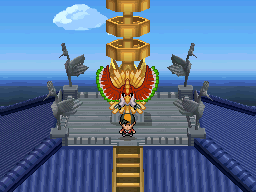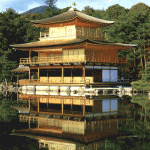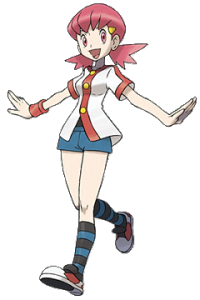The concept of mukokuseki is one used by many recent popular culture products emerging from Japan. The term, literally the quality of “statelessness” or “nationlessness”, is used by Japanese producers of popular culture items to make these items relatable and marketable all over the world. Interestingly enough, one of the products of Japanese popular culture to really send the foreign popularity of Japanese pop culture into the stratosphere was one that, in Japan, was littered with references and locales that only the Japanese would understand and appreciate, a “cultural odor” seen as foreign and exotic to those consumers outside of Japan. (Iwabuchi, 27) This product is one that most in the United States knows as “Pokémon” or, in Japan, “Pocket Monsters.”
Pokémon was a phenomenon in the late 1990s and early 2000s that captured the hearts and minds of children all around the world. Being a 10-year old elementary school student when these titles were released in the United States, in retrospect I now realize how targeted I was in marketing campaigns and how much money my parents had to shell out to appease my hunger for all things Pokémon. It was a shock to most of the world, including the Japanese, apparently, how well this product would sell in the United States, as it was without the action that most games that sold well in the United States had. Games like “Super Mario Brothers” and “Sonic the Hedgehog” were full of action, but this game was quite subdued in comparison, and required strategy and memorization for success, a veritable “thinker” of a title. But it was the freedom that the game gave players that made it so marketable, and the “Gotta Catch ‘Em All” tagline was one that youngsters in America simply could not resist.
From the onset, these titles were marketed as the next big thing from Japan, so it wasn’t as though the Americans were unaware that this product was from Japan. What they undoubtedly are unaware of, however, is the fact that many things were changed in the localization process that gave this game a sense of mukokuseki, yet subtle aspects of Japan were maintained. First off, when superimposed on a map of Japan, the various regions of the alternate “Pokémon” Japan line up nearly perfectly with the actual map of Japan. In fact, it seems as though the creators did not think that this would be as big of a global hit as it actually was, naming the region found in the first generation of titles “Kanto,” mirroring the actual kantou region, containing Tokyo and its surrounding area. In fact, it was not until the “Johto” region of the second generation of titles was revealed that this was known by foreign players. The fact that the kantou region actually exists in Japan would be known primarily to Japanese players of the game, which supports the idea that the creators of these games originally had planned for them to be set in an alternate “Pokémon” Japan, as opposed to a stateless world. However, even though the setting remains physically unchanged between the American and Japanese versions of the game, the similarities between this imagined world and the actual landscape of Japan would, again, only be perceived primarily by Japanese players.
Many of the most famous landmarks in Japan are represented within the “Pokémon” realm of Japan. Again, when superimposed on a map of Japan, the “Kanto” and “Johto” regions fit very nicely within the kantou and kansai areas of Japan, or the eastern and western parts of the main Japanese island of honshuu. This was not a coincidence, however, as the size and locations of many of the major cities in the two regions are properly represented. For example, the largest city found within the first generation of titles, Saffron City or “Yamabuki City” is located very near where the city of Tokyo would be located on the Japanese map, while the largest of the cities in the second generation of titles, Goldenrod City or “Kogane City”, is located very near where the city of Osaka would be located on a map of Japan.

Kanto (Kantou) and Johto (Kansai) located in the south
Not only location, but various famous landmarks and other distinctly Japanese aspects are represented within this world. Connecting the Pokémon versions of Tokyo and Osaka is a mode of transportation perhaps even those living outside of Japan would recognize: the bullet train or shinkansen. More traditional elements of Japan are represented as well, especially in the “Johto” region, mirroring the much older Kansai region of Japan.
In the Johto town of Ecruteak City or “Enju City”, parallel to real-world Kyoto, there lies a pair of towers, the Burned Tower and the Bell Tower (originally known as the Tin Tower). In the narrative within the second generation of Pokémon titles, there is a myth that two huge legendary birds once lived at the top of the two towers before lightning struck the Burned Tower and forced the two birds to flee. In the recent remakes of these second generation titles, the story climaxes as the hero or heroine summons one of the legendary birds to battle. Interestingly enough, this almost perfectly mirrors the two famous towers located in Kyoto: kinkaku-ji and ginkaku-ji. Even more interesting is that the second generation titles were dubbed Gold and Silver, paralleling the translation of the two towers, “temple of the golden pavilion” and “temple of the silver pavilion” respectively. Not coincidentally, the large phoenix-like Pokémon, “Ho-oh,” is met at the top of the Bell Tower, paralleling the phoenix statue perched atop kinkaku-ji. While the close parallels to actual places found in the Pokémon titles may be quite obvious and intentional, some of the more important aspects that eliminate mukokuseki in the Japanese version of these titles are the people met by the hero/heroine.

Ho-oh on Bell Tower

Kinkaku-ji
There are so many aspects of the characters met in these titles that make them colorful in the Japanese version of the games. This vibrancy is not entirely lost in the localized English versions of the series, but there are multiple aspects of language that are nigh untranslatable and, as such, are “lost in localization.”

Osakan.
For instance, within Japan, Osaka is well known for many things, not the least of which is the dialect in which the people living there speak. This is seen in the games’ counterpart of Osaka, “Kogane City”. In the Japanese language version of these games, the strongest of the characters in this city, Akane, speaks in a very noticeable Osaka dialect, using words such as meccha, meaning “very”, and uchi, meaning “I” or “me,” as well as other speech patterns indicative of Osaka dialect.

American.
Another example of this is a character living in the “Kanto” region city of Vermilion or “Kuchiba”, who, in the Japanese version, goes by the name Matis. While in the American versions of the first generation of titles dubs him as the “Lightning American” in a similar fashion to the Japanese versions of the games, it is conveyed in very different ways. In the American version, he is a war hero whose Pokémon saved him during the war; however, in the Japanese version, he is simply an American soldier who speaks in broken Japanese, using English words in katakana script, a Japanese script used mainly for words borrowed from foreign languages, as well as fluctuating between polite and conversation verb endings, a trait commonly seen in beginning learners of the Japanese language.
The language traits found in these characters is an aspect of the games added by game developers that would most likely not be understood by most foreign players, nor would it be feasible to replicate such language aspects in foreign language versions of the titles.
Iwabuchi, Koichi. Recentering Globalization. Durham: Duke University Press, 2002.
Entry contributed by Chris Bubb
This is a very interesting post and these two presentations have been in my thoughts all afternoon. I’m curious about how to conceptualize mukokuseki in terms of soft power. To attempt (and, likely, to fail at least to some degree) to make a Japanese product “stateless” seems to be a good business decision, in that it allows for Japanese products to saturate diverse markets.
At the same time, any attempt to completely strip a product of its Japanese signifiers seems doomed, especially since the (widely available) knowledge of a product’s origin can predispose a consumer to see markers of the host country within something that is otherwise “vanilla.” So while the initial Pokemon game may have been completely vanilla in its gaming experience, it seems most people knew it was somehow associated with some kind of Japanese invasion. People know what’s up, and something that has been made to no longer “be Japanese” can still be seen as “Japanese.” Had the Pokemon folks had American game designers reinterpret the franchise in the American idiom, the same results may not have occurred, and certainly the trajectory you’ve described above would have been more difficult to achieve.
I don’t think there is a mysterious board of besuited people sitting around strategizing about how to maximize infiltration of the American market by some broadly-construed Japanese brand. Or maybe there is. Either way, do you think that mukokuseki is the best strategy for the Japanese who aim to do so? It seems to allow tremendous flexibility, while effectively allowing the Japanese to lay claim to their cultural products even as they take steps to effectively neuter them of associations with Japan.
I, as blasphemous as it may sound, was not the biggest Pokemon fan, so I found this article really informative. About the naming of the regions–the original Kanto staying the same in the English version and such–during the second generation, was the term “Johto” the name of the region in both the Japanese and English versions? I suppose I’m just wondering if the names of the regions were the same in both the original in the translation.
The part about the loss of the original Japanese characters through localization struck a note–localization can go in all directions, can’t it? Just like the 30 second segment in the Ozu documentary we watched, the part when the John Wayne film ended and faded out into the Japanese flag, Though, admittedly the flying of the flag is probably suppose to represent nationalism, which isn’t lost while the Osaka dialect is completely purged… On the other hand, Pokemon probably is not perceived as “distinctly Japanese” to children viewers (though it may be to the avid card collectors), so the man speaking broken Japanese with English inserts would probably result in confusion.
Thank you for the article!
Very interesting article! Do you think that Japan’s current gross national cool, which seems to be most influential among younger generations, has to do with the popularity of these shows and other Japanese products a decade or two ago? Do you think having children exposed to this show and others like it at a young age has led to this wave of Japanophilia? It seems that many of the people I know who have a fascination with Japan say that their interest started something like Pokemon, Sailor Moon, Hello Kitty, etc. They then went on to look at more “authentic” forms of Japanese products, eventually moving on to the more mature Japanese shows and products as they got older. Are watered-down, heavily altered versions of these shows a sort of “gateway drug” into greater interest and consumption of Japanese culture?
I believe the point was brought up in class that the drop of popularity of Pokémon was responsible for the decreased alteration of it, meaning that since fewer people were watching the show, those adapting the show for Western consumption didn’t think it was worth it to change as much. Could this shift towards fewer changes perhaps be instead indicative of increased demand for authenticity?
Also, a question I’ve had for a while that I wanted to know others’ thoughts on — is this mukokuseki, or “statelessness,” the best way to describe Japan’s products? It seems to me that anime, which is often described by the term “mukokuseki,” is a very distinctly Japanese form of animation. Sure, it may not be traditionally Japanese, but the most people do recognize it as Japanese regardless as part of a more modern view of Japan. If people do not really associate anime with any other country, doesn’t that make it defined by Japan and thus cause it to have a “nation”? It may be relatable and have appeal to foreign audiences, but I don’t see how that makes it lack Japaneseness. What do you think?